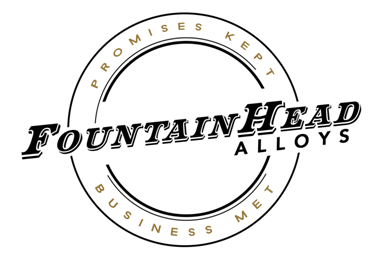Commercially pure titanium, aerospace and aircraft grade titanium, ASTM Grade 23 with diminished oxygen content are bundled together on the packaging the products are delivered with and sometimes they are more bolded than the product price tag and main description.
And though it is clearly implied that this specification should mean something, it is my personal belief that there are few, if any, customers that are metallurgy savvy enough in order to infer of what impact the different titanium grades have on the quality or reliability of the product they are about to pay for.
Classifications of the alloys as titanium grades become necessary with the great development of titanium uses and with the rapid evolution of different titanium alloys in order to provide a common language across titanium production cycle for refiners, smelters, fabricators and recyclers alike. The “American Society for Testing and Materials” maintains this list, and the usual designation of titanium alloys is “ASTM Grades”.
What are Titanium Alloys?
A specification regarding different titanium grades is encountered in almost every titanium product description that manufacturers and distributors make available when presenting a new titanium applications. Commercially pure titanium, aerospace and aircraft grade titanium, ASTM Grade 23 with diminished oxygen content are bundled together on the packaging the products are delivered with and sometimes they are more bolded than the product price tag and main description.
And though it is clearly implied that this specification should mean something, it is my personal belief that there are few, if any, customers that are metallurgy savvy enough in order to infer of what impact the different titanium grades have on the quality or reliability of the product they are about to pay for. Classifications of the alloys as titanium grades become necessary with the great development of titanium uses and with the rapid evolution of different titanium alloys in order to provide a common language across titanium production cycle for refiners, smelters, fabricators and recyclers alike. The “American Society for Testing and Materials” maintains this list, and the usual designation of titanium alloys is “ASTM Grades”.
- Grade 1 – Unalloyed titanium, low oxygen, low strength
- Grade 2 – Unalloyed titanium, standard oxygen, medium strength
- Grade 3 – Unalloyed titanium, medium oxygen, high strength
- Grade 4 – Unalloyed titanium, high oxygen, extra high strength
- Grade 5 – Titanium alloy (6% aluminum, 4% vanadium)
- Grade 7 – Unalloyed titanium plus 0.12% to 0.25% palladium, standard oxygen, medium strength
- Grade 9 – Titanium alloy (3% aluminum, 2.5% vanadium), high strength. Mainly aerospace applications
- Grade 11 – Unalloyed titanium plus 0.12% to 0.25% palladium, low oxygen, low strength
- Grade 12 – Titanium alloy (0.3% molybdenum, 0.8% nickel), high strength
- Grade 13 – Titanium alloy (0.5% nickel, 0.05% ruthenium), low oxygen
- Grade 14 – Titanium alloy (0.5% nickel, 0.05% ruthenium), standard oxygen
- Grade 15 – Titanium alloy (0.5% nickel, 0.05% ruthenium), medium oxygen
- Grade 16 – Unalloyed titanium plus 0.04% to 0.08% palladium, standard oxygen, medium strength
- Grade 17 – Unalloyed titanium plus 0.04% to 0.08% palladium, low oxygen, low strength
- Grade 18 – Titanium alloy (3% aluminum, 2.5% vanadium plus 0.04% to 0.08% palladium)
- Grade 19 – Titanium alloy (3% aluminum, 8% vanadium, 6% chromium, 4% zirconium, 4% molybdenum)
- Grade 20 – Titanium alloy (3% aluminum, 8% vanadium, 6% chromium, 4% zirconium, 4% molybdenum) plus 0.04% to 0.08% palladium
- Grade 21 – Titanium alloy (15% molybdenum, 3% aluminum, 2.7% niobium, 0.25% silicon)
- Grade 23 – Titanium alloy (6% aluminum, 4% vanadium, extra low interstitial, ELI)
- Grade 24 – Titanium alloy (6% aluminum, 4% vanadium) plus 0.04% to 0.08% palladium
- Grade 25 – Titanium alloy (6% aluminum, 4% vanadium) plus 0.3% to 0.8% nickel and 0.04% to 0.08% palladium
- Grade 26 – Unalloyed titanium plus 0.08% to 0.14% ruthenium, standard oxygen, medium strength
- Grade 27 – Unalloyed titanium plus 0.08% to 0.14% ruthenium, low oxygen, low strength
- Grade 28 – Titanium alloy (3% aluminum, 2.5% vanadium) plus 0.08% to 0.14% ruthenium
- Grade 29 – Titanium alloy (6% aluminum, 4% vanadium with extra low interstitial elements (ELI) plus 0.08% to 0.14% ruthenium
Chemical Properties
The chemical properties of titanium are provided in the table below:
| Chemical Data | |
|---|---|
| CAS number | 7440-32-6 |
| Thermal neutron cross section | 5.6 barns/atom |
| Electrode potential | 0.20 V |
| Ionic radius | 0.680 Å |
| Electro negativity | 1.54 |
| X-ray absorption edge | 2.497 Å |
| Electrochemical equivalent | 0.4468 g/A/h |
Physical properties
| Alloy | Density (g.cm-3) |
Melt Range (°C±15) |
Spec. Heat (J.g-1.K-1) |
Elec. Resist. (µΩ.cm) |
|
| Commercially Pure | ASTM Grade 1 | 4.51 | 1670 | 0.54 | 56 |
| Commercially Pure | ASTM Grade 2 | 4.51 | 1677 | 0.54 | 56 |
| Commercially Pure | ASTM Grade 3 | 4.51 | 1677 | 0.54 | 56 |
| Commercially Pure | ASTM Grade 4 | 4.54 | 1660 | 0.54 | 61 |
| Ti-3%Al-2.5%V | ASTM Grade 9 | 4.48 | 1704 | – | 124 |
| Ti-0.8%Ni-0.3%Mo | ASTM Grade 12 | 4.51 | – | 0.54 | 51 |
| Ti-3%Al-8%V-6%Cr-4%Zr-4%Mo | Beta C | 4.81 | 1649 | – | – |
| Ti-15%Mo-3%Nb-3%Al-0.2%Si | Timetal 21 S | 4.90 | – | 0.49 | 135 |
| Ti-6%Al-4%V | ASTM Grade 5 | 4.42 | 1649 | 0.56 | 170 |
| Ti-2.5%Cu | IMI 230 | 4.56 | – | – | 70 |
| Ti-4%Al-4%Mo-2%Sn-0.5%Si | IMI 550 | 4.60 | – | – | 160 |
| Ti-6%Al-6%V-2%Sn | – | 4.54 | 1704 | 0.65 | – |
| Ti-10%V-2%Fe-3%Al | – | 4.65 | 1649 | – | – |
| Ti-15%V-3%Cr-3%Sn-3%Al | – | 4.76 | 1524 | 0.50 | 147 |
| Ti-8%Al-1%Mo-1%V | – | 4.37 | 1538 | – | 198 |
| Ti-11%Sn-5%Zr-2.5%Al-1%Mo | IMI 679 | 4.84 | – | – | 163 |
| Ti-5.5%Al-3.5%Sn-3%Zr-1%Nb-0.3%Mo-0.3%Si | IMI 829 | 4.54 | – | – | – |
| Ti-5.8%Al-4%Sn-3.5%Zr-0.7%Nb-0.5%Mo-0.3%Si | IMI 834 | 4.55 | – | – | – |
| Ti-6%Al-2%Sn-4%Zr-2%Mo | – | 4.54 | 1649 | 0.42 | 191 |
| Ti-6%Al-2%Sn-4%Zr-6%Mo | – | 4.65 | 1635 | – | – |
| Ti-6%Al-5%Zr-0.5%Mo-0.2%Si | IMI 685 | 4.45 | – | – | – |
| Ti-6%Al-3%Sn-4%Zr-0.5%Mo-0.5%Si | Ti 1100 | 4.50 | – | – | 180 |
Applications
The following are the application areas of titanium:
- Pigments, additives and coatings
- Aerospace and marine
- Industrial
- Consumer and architecture
- Jewellery
- Medical
- Nuclear waste storage
Titanium compounds are used as paints, rubber, paper, bleaching and opacifying agents. Titanium alloys are known for their high tensile strength and hence used aircrafts, armour plating and missiles. The alkaline earth titanates are used in ultrasonic vibrations generators and sound generators.
FountainHead Alloys is ISO 9001:2015 approved. © FountainHead Alloys 1996

